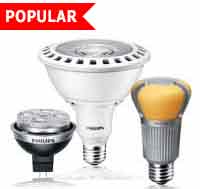LEDs and the Future of Light
Ask and ExpertWill LEDs eventually replace CFLs and incandescent bulbs?
Though the upfront costs are currently high, the future of LED light bulbs is bright. Gary Allen of GE Lighting notes the trend of falling costs per lumen—and what that means for the accessibility of the LED bulb.
One
What initially interested you about LEDs?
I’ve been doing R&D, Innovation, and New Product Introduction (NPI) in Lighting for 26 years—24 of those with GE. My sole focus has been helping to provide lighting solutions that push the envelope toward the ideal light source. Efficacy, color quality, life of the light source, cost, controllability, and infinitesimally small; LEDs are approaching most of those criteria probably 10x faster than any previous light source technology had progressed.
So for me, the opportunity to design new lighting products by leveraging these breakthrough capabilities of LEDs, in combination with the energetic and creative talent that we have within our Innovation and New Product teams at GE Lighting, is a career-long dream come true.
Two
What makes LED lights particularly great as grow lights for plants?
Probably the two most desirable attributes in today’s plant-growing applications are the control of the spectral content of the light and high efficiency (low heat load and low operating cost).
Presently, most plant growing is done with blue and red light, but a recently emerging field in horticulture is the discovery that the ideal spectral content, and the ideal timing of both brightness and colors through the day and the seasons, is different for various types of plants. So, whereas most plant growing now uses blue and deep red LEDs, the future ideal horticultural light sources might have any number of tunable wavelengths adjustable to the specific plants being grown. No legacy light source can provide the combination of high efficiency, tunable spectral content, and controllability of LEDs.
Three
With all the advantages of LEDs, will there continue to be a market for compact fluorescent light bulbs?
LEDs have many advantages over CFLs, but today’s higher cost of LEDs mean that for many consumers CFL is presently the best choice. CFLs are a phenomenally good investment for consumers right now based on electricity savings. The true cost of the 100W incandescent light bulb isn’t the $0.50 price of the bulb. The true cost also includes the electricity used over the 1000-hour life of the bulb, which averages about $12 for US consumers. So, each 100W incandescent bulb costs $12.50, not $0.50.
A typical CFL bulb lasts as long as eight incandescent bulbs. If the consumer buys eight incandescent bulbs instead of one CFL, the real cost of those eight incandescents is $100! CFL buyers understand that. They’re saving about $70 of that $100 for every 26W CFL that they buy. Putting one or two CFLs into your shopping cart might pay for everything else in the cart!
LED lamps that provide as much light as a 100W incandescent bulb are becoming available over the next year or so. They will use about 20-25 watts and will last 25x longer than the incandescent, but they might cost $50 or more. So, the payback time will be about five years versus the three to six months for the CFL.
Interestingly, gas-hybrid cars have about a five-year payback, too. Nonetheless, our intense focus among LED lamp manufacturers is to bring those prices down as quickly as possible. In five years, the cost of LED light bulbs should not be a concern for most consumers. They’ll get a nearly perfect light bulb at an affordable price, and each one will save them $100 or more.
Four
Haitz’s Law says that every decade LEDs will become cheaper by a factor of ten. Do you think this will continue to be true?
Those incredible rates of progress for LEDs have been constant—hardly wavering—since the first visible LED was invented at GE’s Global Research Center by Nick Holonyak in 1962.
That means that over five decades, the cost per lumen has come down by 105. That means that a $1 LED today would have cost $100,000 50 years ago. Those of us who remember those days can attest that LEDs then were used only in expensive, esoteric applications, e.g. in space and in science. That cost trend suggests that today’s $1 LED will cost 10 cents in 10 years. That is a generally accepted projection in the industry, and we’ll probably get there. That forthcoming reduction in cost will make LEDs affordable in almost all applications, and they will probably be the dominant light source in most applications by 2020.
Five
How long do you think it will be before LEDs replace incandescent light bulbs entirely?
The automobile still has not entirely replaced the horse and buggy, people still burn candles for light, and I hope that incandescent lamps are never entirely replaced. Apart from poor efficiency, they are a beautifully elegant product, and some consumers will always love them for special occasions. But, the industry projections suggest that in five years, INC lamp sales will be only about one percent of all lamp sales for general lighting applications. Edison’s iconic invention will have had a 135-year-plus run. I think he would have been extremely pleased.
Source for this article: eComagination











Comments